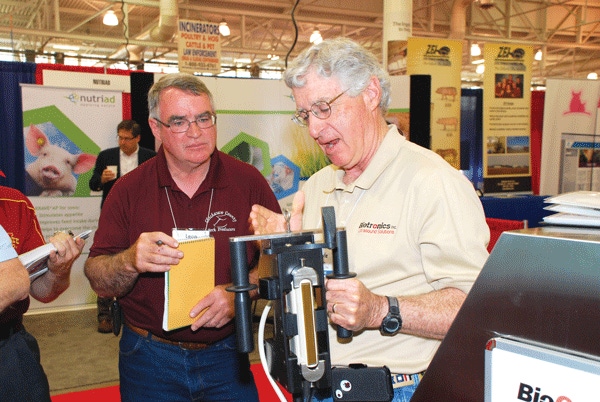This system measures carcass backfat and loin depth and marbling during carcass grading

The BioQscan from Biotronics Inc. is not a new product that will be going home with pork producers for on-farm use. Rather, the product is a non-invasive system for use during carcass grading in the processing plant. Doyle Wilson, president and chief scientist at Biotronics Inc., explained the system accurately measures carcass backfat and loin depth, while also determining loin marbling, within milliseconds.
“Producers could receive added payment benefits for carcasses meeting minimum marbling specifications, while still maintaining high percent-lean values,” Wilson noted. “I’ve always worked for producers, and I feel producers can really benefit from this technology. Producers spend a lot of money on genetics, and this technology could give them some excellent feedback for pork composition traits. It is important to note that BioQscan® uses exactly the same ultrasound technology used by the majority of swine genetics companies.”
The BioQscan system includes the ultrasound scanning system, computer processing center and scanning probe. An ultrasound probe is held up to the carcass as it passes by at line speed. To help minimize user fatigue, the ultrasound measuring unit is held by a counterbalancing weight system. The processing center is housed in a stainless-steel cabinet capable of withstanding the harsh environment of the pork packing plant.
“The system processes information at line speeds, and can fit pork processing capacity from 1,380 carcasses per hour down to lower capacities,” he said.
Information about the percentage of intramuscular fat (IMF) in loins, and carcass percent-lean readings, is instantly available. The unit records multiple pictures of each carcass as the measurements are taken. “An add-on carcass sequence number printer or other numbering system can be provided for plants that don’t have individual carcass identification capabilities,” Wilson said.
Paul Yeske, DVM, asked if the unit needed contact gel in order to work. Wilson said the carcass just needs to be wet, so the water that is normally on the carcass provides the contact needed for ultrasound transmission.
Steve Hoff asked about the IMF accuracy, and Wilson explained that the BioQscan is accurate to a range of +/- 0.5%. He says Biotronics research from different plant trials and Iowa State University research trials shows that the BioQscan IMF prediction model is as good as visual scoring of loin marbling when both are compared to actual chemical fat extracted from the muscle tissue.
Following up on the topic of accuracy, Mike Ellis asked how the user is sure that he or she is holding the unit in the right place to measure last-rib backfat. Wilson said the probe has a vertically aligned guide that the operator places on the carcass midline, and the operators are trained to visually identify the location of the last rib for proper probe placement. Multiple measurements are taken on each carcass. He says the unit will take up to 15 images of the carcass as it is being measured, so any questionable information can be double-checked. “The fact that multiple measurements are taken of each carcass should lead to better accuracy,” Yeske said.
Ellis also asked if the unit could be used for sorting carcasses for specific marbling or to sort hams, for example. Wilson said the potential exists for programming the unit to sort for a variety of factors. He also pointed out that approximately 98% of carcasses can be measured accurately. The majority of the 2% can be manually processed using what is called a digital rollout.
The panel asked what type of calibration would be necessary in order to operate the unit. Wilson explained the BioQscan system can be powered up with the flip of a switch, and all system checks are automatically completed within minutes of turning the system on. The ultrasound scanner is periodically checked for depth measurement calibration using a water-based phantom, according to Wilson. He also noted that a technical support staff is available to help with any problems that may occur.
The bottom-line question for the panel was, how could producers convince packing plants to use the technology?
“Producers need to let their packer buyers know that this technology exists, and that they expect them to use it,” Wilson responded.
Leon Sheets asked, “What type of cost would a plant incur if it wanted to use it?” Wilson explained the basic equipment and installation cost is $125,000. Service and training of the technicians are available on a contract basis.
The panel liked the fact that BioQscan is noninvasive and captures the pictures of each carcass. “This could be another tool to help producers work with their harvest partners to make better decisions about sorting animals and identifying pork quality measurements,” Sheets said.
Learn more at www.Biotronics-inc.com.
About the Author(s)
You May Also Like



